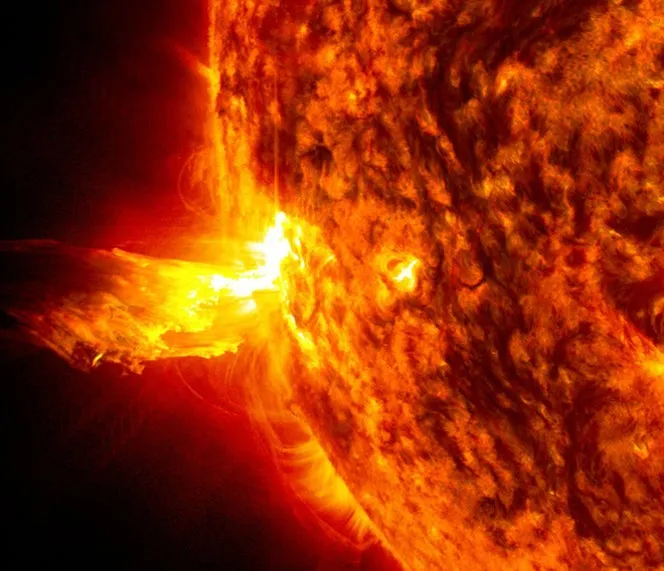Navigating the Solar Storm: NASA’s Warnings and Global Impacts
As humanity becomes increasingly reliant on technology, the interstellar phenomena of solar flares and storms have taken on new significance. NASA has recently issued alarms regarding an uptick in solar activity that could lead to significant communication blackouts across the planet.
The Nature of Solar Flares
Solar flares are bursts of radiation from the sun’s surface, caused by the release of magnetic energy stored in the solar atmosphere. These explosive events can impact the Earth’s magnetosphere, leading to disruptions in radio signals, GPS accuracy, and even power grid functionality. During strong solar flares, radio blackouts can occur across wide areas, especially affecting high-frequency radio communications and satellite operations.
Recent Solar Flare Activity
In early 2025, the strongest solar flare observed recorded an unprecedented scale, with massive implications stretching across Europe, Asia, and the Middle East. This solar event resulted in widespread radio blackouts, demonstrating the reach and power of solar phenomena. Such occurrences are not benign; they pose real threats to national security, aviation safety, and emergency services that rely on reliable communication.
The Impact on Communications
The ramifications of the recent solar storm were felt on at least five continents. Reports emerged of loss of radio transmissions, particularly for flights over polar regions, where navigation systems rely heavily on satellite and radio signals. The implications were immediate, as airlines altered flight paths to ensure safety. Satellite operators also faced challenges, with satellite systems experiencing reduced performance during geomagnetic storms, impacting everything from GPS to television broadcasts.
Scientific Observations and Warnings
NASA and other space weather agencies have been closely monitoring solar activity for decades. With sophisticated satellites such as the Solar and Heliospheric Observatory (SOHO) and the Solar Dynamics Observatory (SDO), scientists can predict solar flares and their potential impacts on Earth. These predictions are crucial for preparing for potential disruptions and deploying preventative measures to mitigate risks.
Advice for Preparedness
NASA and meteorological organizations urge individuals and businesses to remain informed about solar activity. Here are some tips to prepare for possible disruptions:
- Stay Informed: Keep track of solar weather alerts from NASA and NOAA’s Space Weather Prediction Center to understand when solar flares are likely to occur.
- Backup Communication Systems: Businesses and individuals should consider alternative communication methods, such as satellite phones or backup generators for power.
- Monitor Devices: Ensure that crucial devices are charged and operating properly, especially if you rely on technology for business or emergency communications.
Long-term Implications of Solar Activity
As we move deeper into the 21st century, the implications of solar activity become increasingly relevant. The sun operates on an approximately 11-year cycle, oscillating between periods of solar minimum and maximum. We are currently approaching a solar maximum, expected to peak in 2025. Solar flares are more common during this cycle, and with each cycle, we witness advancements in technology that make us more susceptible to solar-related disruptions.
Climate Change and Solar Activity Interaction
Research also suggests a potential connection between solar activity and climate change, though this is a topic of considerable scientific debate. Some studies postulate that fluctuations in solar radiation can influence climatic conditions on Earth, while others argue that anthropogenic (human-caused) factors are far more significant. Understanding these relationships is crucial for developing comprehensive strategies to address global climate challenges.
Solar Preparedness Initiatives
Various governments and organizations are working to bolster global preparedness for solar events. Collaborative frameworks are being established to share information on solar activities and best practices for mitigation. Some nations have developed resilience strategies to strengthen their electric grids and communication networks against solar storms.
International Collaboration is Key
Given that solar flares can have global impacts, international collaboration in addressing these challenges is essential. Space weather scientists are working diligently to improve forecasting models and engage in data-sharing practices. Such collaboration has the potential to save lives and protect critical infrastructure, making it easier to respond effectively when nature unleashes its explosive energy.
The Path Ahead
As we prepare for the potential for large solar events, society must remain cognizant of our vulnerability. Continued research and improvements in forecasting solar activity will prove indispensable as we navigate the complexities of solar phenomena and their impacts on our technologically dependent lives.
Technology in Focus
The advancement of technology has become a double-edged sword: while it enhances our everyday lives, it also heightens our exposure to natural phenomena such as solar flares. Thus, the protection of critical infrastructures such as power grids, satellite networks, and communication systems must remain a priority.
Conclusion
NASA’s warnings about the recent solar activity serve as a stark reminder of the vulnerabilities inherent in our increasingly interconnected world. As solar flares become more common, understanding their implications and establishing frameworks for preparedness will be essential. By consolidating knowledge, developing resilience strategies, and fostering international cooperation, society can mitigate the risks associated with powerful solar storms. After all, the sun’s power can illuminate our world—or plunge it into darkness.







